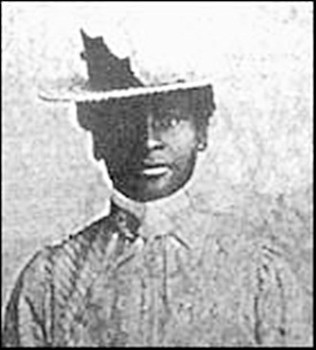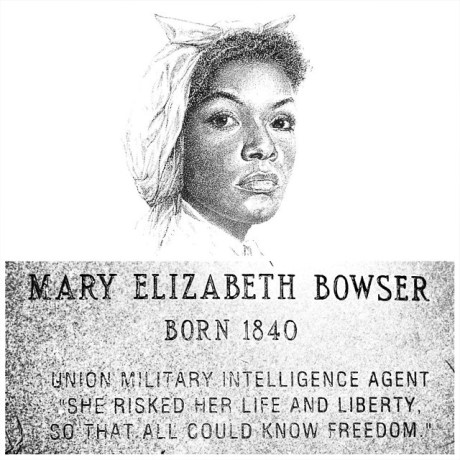Born: a slave c. 1839 in Richmond, Virginia on the plantation of the John Van Lew, a wealthy hardware merchant and his wife Elizabeth Van Lew
Parents: Unknown
Spouse: Wilson Bowser (married April 16, 1861)
Children: 0
Education: A Quaker School for Blacks in Philadelphia
Occupation: Civil War Union Spy
Accomplishments, Achievements, and Contributions:
Details of Mary’s Spy Activities From Wikipedia
Mary was one of the highest placed and most productive espionage agent of the Civil War. Elizabeth Van Lew, John Van Lew’s wife, was the tool used to integrate Mary Elizabeth Bowser into the espionage business. Van Lew had strong ties to the Union and used this to her advantage. She would use an alter-personae which was always distracted and muttered when she spoke in order for people to think she was unbalanced and therefore not someone to take seriously. She was given the nickname “Crazy Bet”. Van Lew was instrumental in establishing a spy system in the Confederate capital. She would regularly visit the Libby Prison with food and medicine, and helped escapees of all kinds, hiding them in a secret room in her mansion. However her biggest accomplishment in espionage was utilizing Mary Elizabeth Bowser.
Because of Bowser’s intelligence and photographic memory, Van Lew decided to make Bowser a spy to infiltrate the confederacy. In order to get access to top-secret information, Bowser became “Ellen Bond”, a slow-thinking, but able, servant. Van Lew, through the help of friends of the Union, was able to have “Ellen Bond” work at functions held by Varina Davis, the wife of the Confederate President, Jefferson Davis, Bowser was eventually hired full-time and worked in the Davis household until just before the end of the war. At the Davis house Bowser worked as a servant, cleaning and serving meals. Because of the racism that existed then, the slaves were trained to act and seem invisible. Usually not noticed at all. Bowser was able to get incredible amounts of information simply by doing her work. The assumption was that slaves could not read or write, nor understand the complex political conversations being held. However, due to Bowser’s education and keen perception, she was able to read and remember any papers that were left around in Jefferson Davis’ study and report the information to the other spies. She would also spy on conversations and relay back to Van Lew all that was going on in Davis’ house.
There was another spy, Thomas McNiven, with whom Bowser would work. He was a baker in Richmond and would make deliveries to the Davis household. Bowser would relay the information to McNiven who had a team of people come in and out of his bakery to dispatch the related information. According to McNiven, Bowser was the source of the most crucial information because as he wrote in his journal, “she was working right in the Davis home and had a photographic mind. Everything she saw on the Rebel President’s desk, she could repeat word for word. Unlike most colored, she could read and write. She made a point of always coming out to my wagon when I made deliveries at the Davis home to drop information.” (quoted in Waitt, Thomas McNiven Papers.)
Jefferson Davis had become aware that there was a leak in his house, but for a while he did not realize it was Bowser. Thomas McNiven was found out to be a spy and soon suspicion fell on Bowser. She chose to flee in January 1865, but she did not go quietly. Her last act as a spy was an attempt to burn down the Confederate White House. She was not successful. After the war ended, the federal government destroyed any records of evidence of espionage in order to protect those involved, McNiven and Bowser. Therefore, the extent of information gathered by Bowser is unknown. A significant amount made its way to General Ulysses S. Grant and influenced his decisions from 1863-1864.
There was enough information for Bowser to write a journal chronicling her wartime efforts.[2] The journal, too, is lost to us today because her family members mistakenly discarded it in 1952. The Bowser family rarely discussed their work because of the postwar climate in Richmond and attitudes towards Union sympathizers. There is no record of Mary Bowser’s post-war life and no date of death. Bowser is one of many African-American female spies who worked for the Union during the Civil War, yet her works are hardly known to us today.
Awards and/or Honors: She is honored for her work in the Military Intelligence Hall of Fame in Fort Huachuca, Arizona
Death: Unknown
I salute this AMAZING HER-story making sista!
Sources:


Dope story!!
LikeLiked by 1 person
Now this would be a great film! Amazing story!
LikeLiked by 1 person
It sure would, but unfortunately much is not known about her life.
LikeLiked by 1 person
Yeah that’s true. That needs to change.
LikeLike
You can read THE SECRETS OF MARY BOWSER now — and someone is optioning it to make a film about Bowser, but that will be a few years away.
LikeLike
I’m delighted you share an interest is Bowser and want to spread the word. But:
1. The Wikipedia entry is full of false information regarding Bowser. Please see the Encyclopedia of Virginia for an accurate entry http://www.encyclopediavirginia.org/Bowser_Mary_Richards_fl_1846-1867
2. That photograph is NOT of the slave-turned-spy. You can learn more about it here: http://www.theatlantic.com/technology/archive/2013/06/the-spy-photo-that-fooled-npr-the-us-army-intelligence-center-and-me/277276/
3. You and your readers might enjoy the book THE SECRETS OF MARY BOWSER, which is a novel based on Bowser’s life. Too little is known about her for a full biography, but MANY of the black women in the novel (Harriet Newby, Margaretta Forten, Sarah Mapps Douglas, etc) were real people and the details about their lives included in the novel are all true.
LikeLiked by 1 person
@ Lois
Thank you for providing the links to accurate information about Mary. I will be reviewing and revising the post soon. I guess its easy to come across inaccurate and or false information when much is not known about a person’s life.
LikeLike
Thank you SO MUCH for information about this awesome woman! I’m truly inspired by her story!
LikeLiked by 1 person
Thank you! It was my pleasure!
LikeLike